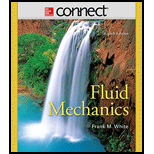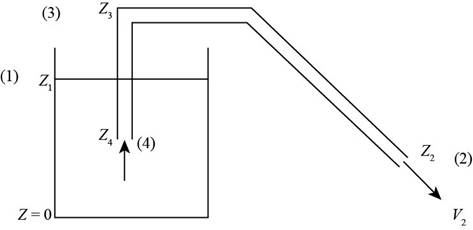
The exit velocity of siphon tube with friction head losses.
The volume flow rate of the siphon tube with friction head losses.
The variation between the exit velocity and volume flow rate with and without friction head losses.
Answer to Problem 3.132P
The exit velocity of siphon tube with friction head losses
The volume flow rate of the siphon tube with friction losses head
The velocity and volume flow rate through the siphon tube is more if there is no head loss in the tube.
Explanation of Solution
Given information:
The diameter of the tube is
The Figure-(1) show different height at different sections.

Figure-(1)
Here, the section (1) is for the top of the water level in the left region, the section (2) is at the exit of the siphon tube
Write the expression for the Bernoulli’s equation between the section (1) and section (2) of the given system.
Here, the pressure at section (1) is
Since the fluid at section (1) is stationary, so the velocity at the sections (1) is zero.
Since the pressure at the section (1) and section (2) is atmospheric, so the difference between the pressures is zero.
Write the expression for friction head loss in the siphon tube.
Here, the friction head loss in the siphon tube is
Substitute
Here, the exit velocity at section (2) with friction head losses is
Substitute
Here, the exit velocity at section (2) without friction head losses is
Write the expression for the flow rate at section (2) with friction losses.
Here, the flow rate is
Write the expression for the flow rate at section (2) without friction head losses.
Here, the flow rate is
Calculation:
Substitute
Substitute
Here diameter of the siphon tube is
Substitute
Substitute
Here diameter of the siphon tube is
Conclusion:
The exit velocity of siphon tube with friction head losses
The volume flow rate of the siphon tube with friction losses head
The velocity and volume flow rate through the siphon tube is more if there is no head loss in the tube.
Want to see more full solutions like this?
Chapter 3 Solutions
Connect 1 Semester Access Card For Fluid Mechanics
 Elements Of ElectromagneticsMechanical EngineeringISBN:9780190698614Author:Sadiku, Matthew N. O.Publisher:Oxford University Press
Elements Of ElectromagneticsMechanical EngineeringISBN:9780190698614Author:Sadiku, Matthew N. O.Publisher:Oxford University Press Mechanics of Materials (10th Edition)Mechanical EngineeringISBN:9780134319650Author:Russell C. HibbelerPublisher:PEARSON
Mechanics of Materials (10th Edition)Mechanical EngineeringISBN:9780134319650Author:Russell C. HibbelerPublisher:PEARSON Thermodynamics: An Engineering ApproachMechanical EngineeringISBN:9781259822674Author:Yunus A. Cengel Dr., Michael A. BolesPublisher:McGraw-Hill Education
Thermodynamics: An Engineering ApproachMechanical EngineeringISBN:9781259822674Author:Yunus A. Cengel Dr., Michael A. BolesPublisher:McGraw-Hill Education Control Systems EngineeringMechanical EngineeringISBN:9781118170519Author:Norman S. NisePublisher:WILEY
Control Systems EngineeringMechanical EngineeringISBN:9781118170519Author:Norman S. NisePublisher:WILEY Mechanics of Materials (MindTap Course List)Mechanical EngineeringISBN:9781337093347Author:Barry J. Goodno, James M. GerePublisher:Cengage Learning
Mechanics of Materials (MindTap Course List)Mechanical EngineeringISBN:9781337093347Author:Barry J. Goodno, James M. GerePublisher:Cengage Learning Engineering Mechanics: StaticsMechanical EngineeringISBN:9781118807330Author:James L. Meriam, L. G. Kraige, J. N. BoltonPublisher:WILEY
Engineering Mechanics: StaticsMechanical EngineeringISBN:9781118807330Author:James L. Meriam, L. G. Kraige, J. N. BoltonPublisher:WILEY





